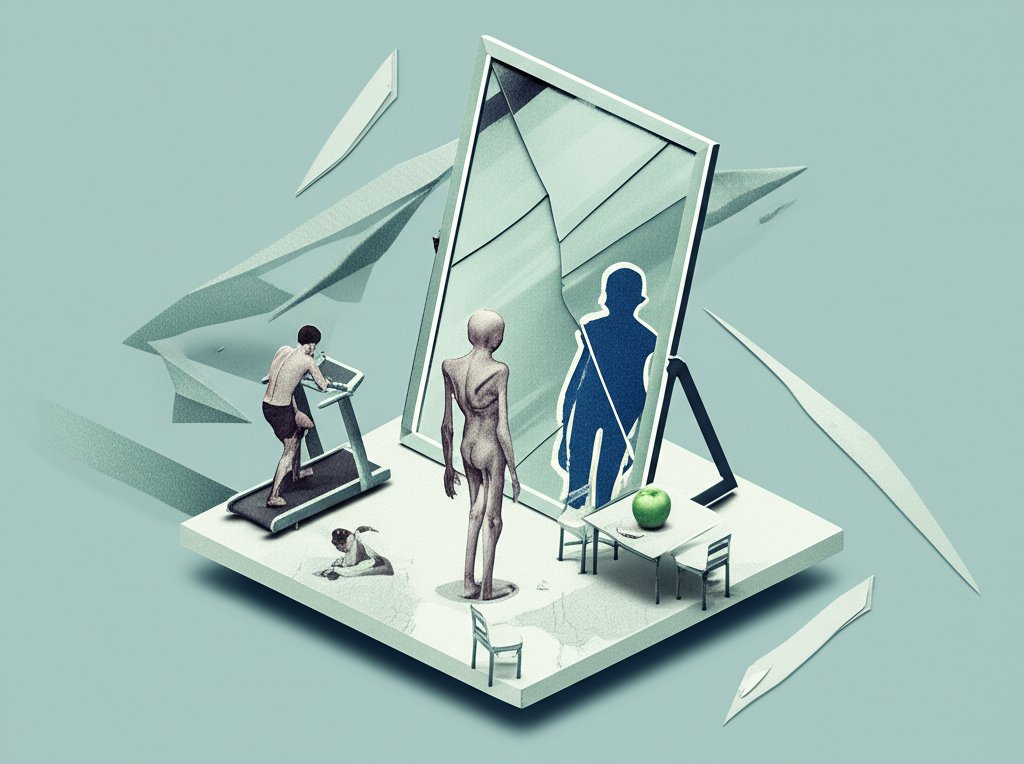The image of anorexia nervosa is so deeply ingrained in our culture that we can picture it instantly: a frail teenage girl, terrified of food, chasing an impossible standard of thinness. This stereotype is powerful, persistent, and dangerously incomplete. The hidden reality is that countless males with anorexia nervosa are struggling in silence, their illness rendered invisible by the very stereotype that defines it. They are fighting a different battle, driven by different pressures, and experiencing different physical consequences—often without the language or support to even name what is happening.
This isn’t a niche issue. This is a public health blind spot. And understanding the unique ways anorexia manifests in men isn’t just about fairness; it’s about saving lives.
At a Glance: What You Need to Know
For those short on time, here are the essential takeaways about anorexia in males:
- It’s More Common Than You Think: Roughly one in three people with an eating disorder is male. In the United States alone, an estimated 6.6 million men will be affected in their lifetime.
- The “Ideal” Is Different: While some men pursue thinness, many are driven by a desire for a lean, muscular physique. This can lead to a confusing mix of food restriction and compulsive exercise.
- Symptoms Can Be Unique: Men experience gender-specific medical complications, including dangerously low testosterone, vitamin D deficiency, and a high risk of bone density loss (osteopenia and osteoporosis).
- Diagnosis Is Often Missed: Cultural biases, stigma, and a lack of awareness in the medical community mean men are far less likely to be diagnosed or seek help.
- Treatment Must Be Tailored: Effective recovery requires a gender-sensitive approach that addresses male-specific body image issues, compulsive exercise, potential steroid use, and unique medical needs.
The Invisible Struggle: Why We Overlook Anorexia in Men
For decades, we’ve been told a one-sided story. Eating disorders were framed as a “women’s issue,” a tragic consequence of societal pressure on girls. This narrative left no room for men. As a result, a man who is restricting food, obsessing over his body, and compulsively exercising often doesn’t see his behavior as a symptom of an illness. He might just think he’s being “disciplined” or “dedicated” to fitness.
The statistics tell a different story. Subclinical disordered eating behaviors—like bingeing, purging, and fasting for weight control—are nearly as common in men as they are in women. Yet the myth that these are exclusively female problems persists, creating a formidable barrier. This cultural blindspot is a major barrier, but the first step is always Understanding male eating disorders in their full complexity.
This stigma prevents men from recognizing their own symptoms and discourages them from seeking help. Many fear being seen as weak, vain, or not “manly.” Others worry they won’t be taken seriously by doctors or that they’ll be the only man in a treatment program—a fear that is often justified.
It’s Not Just About Being Thin: The Drive for Muscularity
When you hear “anorexia,” you think “weight loss.” But for many men, the goal isn’t just to be smaller; it’s to be leaner and more muscular. The “ideal” male body promoted in media isn’t skeletal—it’s ripped, with low body fat and significant muscle definition.
This creates a paradoxical and dangerous set of behaviors. A man might severely restrict calories or cut out entire food groups to eliminate body fat while simultaneously engaging in punishing, hours-long workouts to build muscle.
This drive for a lean, muscular build is fueled by several factors:
- Media Portrayals: Unattainable physiques are presented as the norm for men in movies, advertising, and on social media.
- Peer Influence: Gym culture and social circles can create an echo chamber where obsessive fitness and restrictive diets are normalized and even celebrated.
- Gender Role Expectations: Traditional ideas of masculinity often tie a man’s value to his physical strength and appearance.
Research shows this disconnect is widespread. One study found that 27% of normal-weight men incorrectly perceive themselves as underweight or “too skinny.” This dissatisfaction fuels what experts call “muscularity-oriented disordered eating,” where behaviors like obsessive supplement use and even anabolic steroid abuse become part of the picture.
Is It Anorexia or Muscle Dysmorphia?
The focus on muscle can sometimes lead to a related but distinct condition called muscle dysmorphia. Often called “bigorexia,” it’s a subtype of body dysmorphic disorder (BDD) where an individual becomes obsessed with the idea that they are not muscular enough.
While there’s significant overlap, understanding the core motivation is key to proper diagnosis and treatment.
| Core Feature | Anorexia Nervosa (in Males) | Muscle Dysmorphia |
|---|---|---|
| Primary Fear | Fear of gaining fat; desire for leanness. | Fear of being too small or not muscular enough. |
| Body Image | Sees self as overweight, even when dangerously underweight. | Sees self as scrawny and weak, even when very muscular. |
| Dietary Pattern | Primarily restrictive (calories, carbs, fats). | Often involves complex, rigid high-protein diets and cycles of “bulking” and “cutting.” |
| Exercise Pattern | Often focused on cardio and calorie burning. | Primarily focused on weightlifting and resistance training. |
| Key Behavior | Severe food restriction is the central behavior. | Compulsive, excessive time in the gym is the central behavior. |
| Common Overlap | Both can involve rigid food rules, social isolation, obsessive body-checking, and a profound sense of inadequacy. A man can also have both. | Both can involve rigid food rules, social isolation, obsessive body-checking, and a profound sense of inadequacy. A man can also have both. |
| A man with anorexia might spend hours on a treadmill to burn fat, while a man with muscle dysmorphia will spend hours lifting weights to build mass. Both may be using supplements excessively, but the man with muscle dysmorphia is at a much higher risk for using androgenic anabolic steroids to achieve his goals. |
The Physical Toll: Gender-Specific Health Risks You Can’t Ignore

Anorexia nervosa is one of the deadliest mental illnesses for all genders, but the risks for men are stark. The mortality rate for men with eating disorders is 6 to 8 times higher than for men in the general population. The physical breakdown caused by malnutrition and over-exercise creates a cascade of specific medical problems.
Low Testosterone (Hypogonadism)
When the body is starved of energy, it shuts down non-essential functions, including the production of sex hormones. For men, this results in a sharp drop in testosterone.
Symptoms of low testosterone include:
- Extreme fatigue and low energy
- Loss of libido (sex drive)
- Depression and irritability
- Loss of muscle mass
- Inability to concentrate
Low testosterone isn’t just a side effect; it’s a serious medical condition that worsens the psychological state and physical health of a man with anorexia.
Bone Density Loss (Osteopenia and Osteoporosis)
Most people associate osteoporosis with older women, but it is a severe and often overlooked risk for males with anorexia nervosa. Testosterone plays a crucial role in maintaining bone density. When testosterone levels plummet due to malnutrition, the bones begin to weaken and demineralize.
This is compounded by low levels of vitamin D and calcium, which are common in those with restrictive diets. The bone loss can be rapid, irreversible, and lead to a lifetime risk of fractures.
The Dangers of “Enhancement”
The pressure to be muscular means many men with disordered eating turn to performance-enhancing drugs, particularly anabolic steroids. This adds another layer of medical complexity. Steroid use can cause:
- Severe mood swings (“‘roid rage”) and paranoia
- Liver damage and cardiovascular problems
- Further disruption of the body’s natural hormone production
A comprehensive treatment plan must screen for and address substance use, as it can complicate both medical stabilization and psychological recovery.
Finding the Right Help: What Effective Treatment for Men Looks Like
Once a man finds his way to treatment, his chances of recovery are just as good as a woman’s. The challenge is getting him there and ensuring the care he receives is tailored to his unique needs. A “one-size-fits-all” approach designed for teenage girls will likely fail a grown man.
Effective, gender-sensitive treatment must be built on a few key pillars.
1. A Welcoming and Relevant Environment
Many men report feeling isolated and out of place in treatment settings dominated by women. They may feel their core issues—like compulsive exercise or the drive for muscularity—are not understood.
Finding a program or a therapist who has explicit experience treating men is critical. Group therapy, for instance, can be more effective if it includes other men who can validate these unique experiences.
2. Medically-Informed Care
A thorough medical evaluation is the first step. This must include:
- Hormone Panels: Checking testosterone levels is non-negotiable. If they are critically low, a doctor may recommend testosterone supplementation as part of the recovery plan to help restore energy, mood, and bone health.
- Bone Density Scans (DEXA): Assessing for osteopenia or osteoporosis is essential to create a plan for preventing fractures and rebuilding bone mass.
- Nutritional Bloodwork: Checking for deficiencies in vitamin D, iron, and other key micronutrients is vital.
3. Psychology That Speaks to Men
Therapy needs to address the underlying drivers of the disorder. This means going beyond the fear of fat and exploring themes more common in men:
- Perfectionism and a rigid, “all-or-nothing” mindset.
- Difficulty identifying and expressing emotions (alexithymia).
- The connection between the body, strength, and self-worth.
- Co-occurring conditions like anxiety, depression, and substance use.
Cognitive Behavioral Therapy (CBT) is often effective, as it helps individuals challenge the distorted thoughts that fuel their behaviors.
4. A New Relationship with Food and Exercise
Nutritional rehabilitation for men can look different. A dietitian should work with the patient to:
- Challenge “Good” vs. “Bad” Food Labels: Especially those related to fitness culture (e.g., fear of carbs or fats).
- Establish a Sustainable Meal Plan: One that supports both weight restoration and healthy muscle mass without triggering obsessions.
- Reintroduce Exercise Safely: Compulsive exercise must be stopped completely during the initial phases of recovery. Later, a healthy, balanced movement routine can be reintroduced under the guidance of the treatment team, focusing on enjoyment and health rather than calorie burning or body sculpting.
Frequently Asked Questions About Men and Anorexia
What are the early warning signs of anorexia in a man or teenage boy?
Look for changes in behavior, not just weight. Common signs include:
- Sudden or rigid new diets (e.g., cutting out carbs, fats, or entire food groups).
- Obsessive focus on “clean eating,” protein intake, or supplement schedules.
- Spending excessive hours at the gym, and showing distress if a workout is missed.
- Withdrawing from social situations, especially those involving food.
- Obsessively weighing himself or checking his body in the mirror for muscle definition.
- A noticeable increase in irritability, fatigue, or depression.
Is anorexia in men connected to sexuality?
No. This is a harmful myth. While early research focused on gay men, we now know that anorexia and other eating disorders affect men of all sexual orientations—gay, straight, and bisexual—at similar rates. The disorder is a complex mental illness, not a reflection of one’s identity.
How is anorexia in men different from anorexia in women?
The core illness—a deadly combination of restriction, distorted body image, and fear—is the same. The key differences are in the expression and the experience:
- The Goal: Often leanness and muscle, not just thinness.
- The Behaviors: More likely to involve compulsive exercise and supplement/steroid use.
- The Medical Signs: Low testosterone and its consequences are male-specific.
- The Social Context: Men face more stigma and are less likely to be identified or seek care.
Can men fully recover from anorexia?
Absolutely. Recovery is possible and happens every day. The path is challenging, but with specialized, gender-informed treatment, men can heal their relationship with food, their bodies, and themselves. The key is early intervention and finding care that sees and understands the complete picture.
Your Next Step: How to Move Forward
Whether you are reading this for yourself or for someone you care about, the silence around male eating disorders ends when we start taking action. The path forward is built on courage, compassion, and the right professional support.
If you are struggling:
- Acknowledge the Fight. What you are going through is real, it’s serious, and it is not a character flaw. It is a medical and psychological illness. Naming it is the first act of taking back control.
- Confide in One Person. You don’t have to tell everyone, but find one person you trust—a partner, a friend, a family member, a coach—and tell them you’re having a hard time. Saying it out loud can lift an immense weight.
- Seek a Professional Evaluation. Look for a therapist, doctor, or treatment center that explicitly mentions experience with men and eating disorders. Ask them directly: “How do you tailor your approach for male patients?”
If you are concerned about a man in your life: - Speak from a Place of Care, Not Accusation. Use “I” statements. Instead of “You’re exercising way too much,” try “I’m worried about you. I’ve noticed you seem really exhausted and are spending all your free time at the gym.”
- Focus on Health and Feelings, Not Food or Weight. He is likely to become defensive if you comment on his body or what he’s eating. Instead, focus on observable changes in his mood, energy, and happiness. Ask him how he’s feeling.
- Offer Help Without Ultimatums. Suggest finding resources together. Say, “I’ve been reading about this, and it sounds incredibly difficult. Would you be open to just talking to someone who specializes in this?” Offer to help make the call or go to the first appointment.
The road to recovery begins with recognizing that males with anorexia nervosa are not an anomaly. They are a significant, underserved group with distinct needs, and they deserve care that is just as nuanced, compassionate, and robust as their struggle.
- Plastic Bento Boxes Face Scrutiny Over Sustainability Impacts - December 11, 2025
- Bento Tray Revolutionizes Organized Meal Transport and Presentation - December 10, 2025
- Meal Plans for Busy Schedules That Make Healthy Eating Easy - December 10, 2025










